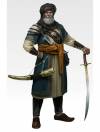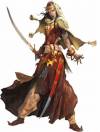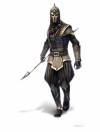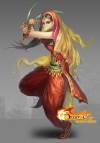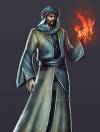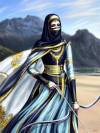Table of Contents
Sakaran Clothes
Overview
From the diaries of Flower Nightsky, chronicler of Berhof.
“The Land of Fate is south of our lands, and it is much hotter and drier there. Clothing is much lighter than here, and often features loose layers made of light materials, although head scarves, turbans and veils are also common. The philosophy holds true for warriors and travellers, who wear lighter armour and weaponry than our own, this is probably due to the debilitating effects of wearing heavier armour in the heat. Because of this, most warriors prefer lighter weapons and rely on mobility, rather than metal, for their protection. The clothes of those who work in the fields, industry or about town, are simpler but follow the same styles.”
At the Market
Clothing
Aba: The traditional desert robe, simple and flowing in design. Most abas (pronounced AH-bahs) are monochromatic—black, brown, and white being favorite colors. The amount and type of embroidery on the edges reflects the relative luxury of the garment; the best abas are trimmed with threads of gold. Some abas may be made of dyed fabric and bright colors, especially those designed for festival days and special occasions. The aba is closed at the waist with a sash and has full, open sleeves. It is traditionally worn with a keffiyeh (headcloth) and an agal.
Caftan: A flowing ankle-length overgarment, cinched at the waist with a sash. Most caftans are made of cotton, but richer versions are made of silk or brocade, and stitched with rich embroidery.
Dolman: A loose, floor-length robe with sleeves, similar to the aba but preferred in more urban areas as a common form of dress.
Dishdashah: A simple tunic, usually worn by farmers and poor merchants. Length varies between the knees and ankles, and the dishdasha (dish-DAHshah) is held closed by a belt, rope, or sash.
Jellaba: A heavy “winter aba,” worn over the traditional aba, and usually made of wool or felt. The jellaba (jell-AH-bah) runs to the ground and is typically less decorative than the aba worn underneath.
Headwear
Keffiyeh: The traditional headcloth worn by most men and women of Zakhara. Length and style varies from tribe to tribe and from city to city, and sometimes from family to family. The keffiyeh (keh-FEE-yeh) is held in place by the agal.
Agal: A cord or group of cords designed to hold a keffiyeh (headcloth) snugly to the head. Basic versions are simply hemp cords, but more ornate agals (ah- GAHLZ) are made of silk, and some are trimmed with semi-precious stones and dusted with gold.
Turban wrap: A long strip of fabric wrapped around the head to produce the turban common in many cities in the Land of Fate. If wrapped around a skull cap, the turban is a flattened sphere. If wrapped around a fez or other support, the turban is taller, rounder, and more impressive. The turban wrap is often held in place by a pin or broach, particular if the wearer is of high stature.
Fez: A round felt hat for men that looks like a short cone with a flat top. A tassel roughly as high as the hat hangs from the crown. Most fezes stand about 6 inches high and are red with a black tassel.
Jewellery
Anklet: A bracelet worn loosely above the feet, usually made of silver. Anklets are a common form of feminine vanity in Zakhara. More ornate versions are made of gold and set with small bells.

